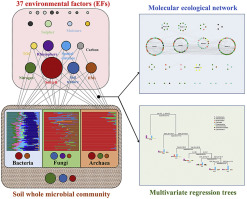Environmental Pollution ( IF 8.9 ) Pub Date : 2017-11-15 , DOI: 10.1016/j.envpol.2017.11.037 Songqiang Deng , Tan Ke , Longtai Li , Shenwen Cai , Yuyue Zhou , Yue Liu , Limin Guo , Lanzhou Chen , Dayi Zhang

|
Rhizospheric microbes play important roles in plant growth and heavy metals (HMs) transformation, possessing great potential for the successful phytoremediation of environmental pollutants. In the present study, the rhizosphere of Elsholtzia haichowensis Sun was comprehensively studied to uncover the influence of environmental factors (EFs) on the whole microbial communities including bacteria, fungi and archaea, via quantitative polymerase chain reaction (qPCR) and high-throughput sequencing. By analyzing molecular ecological network and multivariate regression trees (MRT), we evaluated the distinct impacts of 37 EFs on soil microbial community. Of them, soil pH, HMs, soil texture and nitrogen were identified as the most influencing factors, and their roles varied across different domains. Soil pH was the main environmental variable on archaeal and bacterial community but not fungi, explaining 25.7%, 46.5% and 40.7% variation of bacterial taxonomic composition, archaeal taxonomic composition and a-diversity, respectively. HMs showed important roles in driving the whole microbial community and explained the major variation in different domains. Nitrogen (NH4-N, NO3-N, NO2-N and TN) explained 47.3% variation of microbial population composition and 15.9% of archaeal taxonomic composition, demonstrating its influence in structuring the rhizospheric microbiome, particularly archaeal and bacterial community. Soil texture accounted for 10.2% variation of population composition, 28.9% of fungal taxonomic composition, 19.2% of fungal a-diversity and 7.8% of archaeal a-diversity. Rhizosphere only showed strong impacts on fungi and bacteria, accounting for 14.7% and 4.9% variation of fungal taxonomic composition and bacterial a-diversity. Spatial distance had stronger influence on bacteria and archaea than fungi, but not as significant as other EFs. For the first time, our study provides a complete insight into key influential EFs on rhizospheric microbes and how their roles vary across microbial domains, giving a hand for understanding the construction of microbial communities in rhizosphere.
中文翻译:

环境因素对耐金属植物根际中整个微生物群落的影响:Elsholtzia haichowensis Sun
根际微生物在植物生长和重金属(HMs)转化中起着重要作用,具有对环境污染物进行成功的植物修复的巨大潜力。在本研究中,Elsholtzia haichowensis的根际通过定量聚合酶链反应(qPCR)和高通量测序,对Sun进行了全面的研究,以揭示环境因素(EFs)对整个微生物群落(包括细菌,真菌和古细菌)的影响。通过分析分子生态网络和多元回归树(MRT),我们评估了37种EF对土壤微生物群落的不同影响。其中,土壤pH,HMs,土壤质地和氮被认为是影响最大的因素,它们的作用因领域而异。土壤pH为上古细菌和细菌群落但不是真菌的主要环境变量,解释25.7%,46.5%和细菌分类组成的40.7%的变化,古细菌分类学组成和一个-多样性。HMs在驱动整个微生物群落方面显示出重要作用,并解释了不同领域的主要差异。氮(NH 4 -N,NO 3 -N,NO 2 -N和TN)解释了微生物种群组成的47.3%变化和古生生物分类组成的15.9%,表明了其在构造根际微生物组特别是古生细菌和细菌群落方面的影响。土壤质地占人口组合物的10.2%的变化,真菌分类学组合物的28.9%,真菌的19.2%一-diversity和古7.8%一-多样性。根际只显示出对真菌和细菌强烈的冲击,占14.7%和真菌分类组成和细菌的4.9%的变化一个-diversity。空间距离比真菌对细菌和古细菌的影响更大,但不如其他EF显着。我们的研究首次首次全面了解了影响根际微生物的关键EF,以及它们在整个微生物域中的作用如何变化,为了解根际微生物群落的构建提供了帮助。

























 京公网安备 11010802027423号
京公网安备 11010802027423号